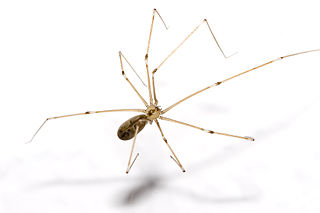
The Pholcidae are a family of araneomorph spiders. The family contains more than 1,800 individual species of pholcids, including those commonly known as cellar spider, daddy long-legs spider, carpenter spider, daddy long-legger, vibrating spider, gyrating spider, long daddy, and skull spider. The family, first described by Carl Ludwig Koch in 1850, is divided into 94 genera.

Pholcus is a genus of spiders in the family Pholcidae, with 375 described species as of January 2023.

Pholcus phalangioides, commonly known as daddy long-legs spider or long-bodied cellar spider, is a spider of the family Pholcidae. It is also known as the skull spider, since its cephalothorax is said to resemble a human skull. This is the only spider species described by the Swiss entomologist Johann Kaspar Füssli, who first recorded it in 1775. Its common name of "daddy long-legs" should not be confused with a different arachnid group with the same common name, the harvestman (Opiliones).
Micropholcus is a genus of cellar spiders that was first described by Christa Laetitia Deeleman-Reinhold & J. D. Prinsen in 1987.
Sihala ceylonicus, is a species of spider of the genus Sihala. It is known to be endemic to Sri Lanka, some suggest its presence in Malaysia as well.
Sihala is a genus of cellar spiders in the family Pholcidae, containing two species. The two species were once classified in the genus Pholcus, but were moved due to the absence of the characteristic sclerites shown in the bulb, and the unusually small and simple procursus.
Tissahamia ethagala is a species of spider in the family Pholcidae. It is endemic to Sri Lanka.
Tissahamia maturata is a species of spider in the family Pholcidae. It is endemic to Sri Lanka.
Wanniyala agrabopath, is a species of spider of the genus Wanniyala. It is endemic to Sri Lanka. The species was described with a male found from Agrabopath Forest, Agrapatana, hence the specific name.
Wanniyala hakgala is a species of spider of the genus Wanniyala. It is endemic to Sri Lanka. The species was described with a male found from Hakgala area, hence the specific name.
Wanniyala is a genus of cellar spiders native to Sri Lanka, first described by Huber & Benjamin in 2005. They have six eyes and four pair of legs and grow up to 2 mm in length. The abdomen is globular and males have a distinctive distal hinged sclerite on the procursus of genitalia. The name is derived from the Sri Lankans native to the island that the first spiders were found on- the Vedda people- and their surname Wanniyala-Aetto.
Tissahamia is a genus of southeast Asian cellar spiders named after Wanniyalaeto chief Uru Warige Tissahami. It was erected in 20180 for several species transferred from Pholcus after a molecular phylogenetic study of the Calapnita-Panjange clade of Pholcidae. They have long, thin abdomens that bend upward near the end. They also have six eyes, three on each of two eye stalks.
Apokayana is a genus of southeast Asian cellar spiders named after the Apo Kayan people of Indonesia and Malaysia. It was erected in 2018 for ten species transferred from Panjange after a molecular phylogenetic study of Pholcidae.
Kelabita is a small genus of southeast Asian cellar spiders. The genus was erected in 2018 for two species transferred from Pholcus after a molecular phylogenetic study of Pholcidae. It is named after the Kelabit, an ethnic group native to Borneo. They build domed webs up to 2 metres above the ground, and can be distinguished by unique sclerotization, including a partially sclerotized embolus. As of April 2022 it contains only two species: K. andulau and K. lambir.

Kintaqa is a genus of southeast Asian cellar spiders erected in 2018 for five species moved from Pholcus after a molecular phylogenetic study. They are medium sized spiders, distinguished by the unique enlarged shape of fourth segment of pedipalps.
Meraha is a genus of southeast Asian cellar spiders. The genus was erected in 2018 for two species transferred from Pholcus after a molecular phylogenetic study of Pholcidae. The name is derived from the Malay "merah", meaning "red", referring to the reddish-orange hue of pedipalps. They are average sized cellar spiders with a cylindrical abdomen, and they build domed webs .5 to 2 metres above the ground.
Muruta is a small genus of southeast Asian cellar spiders named after the Murut people. It was erected in 2018 for two species transferred from Pholcus after a molecular phylogenetic study of Pholcidae. They are average size for cellar spiders with relatively long legs, the first legs averaging 35 to 40 millimetres long. Males can be distinguished from other species by hairless, flat sclerites on their chelicerae, and females can be distinguished by three-layered telescopic tubes in their genital structure. As of April 2022 it contains only two species, both native to northern Borneo: M. bario and M. tambunan.
Nipisa is a genus of southeast Asian cellar spiders erected in 2018 after a molecular phylogenetic study of Pholcidae. It consists of ten Calapnita species, previously the phyllicola group of Pholcidae, now elevated to genus rank. They are pale whitish in color, with a cylindrical abdomen and relatively long legs. The name is derived from the Malay "nipis", meaning "thin", in reference to the long, thin abdomen.
Teranga is a genus of southeast Asian cellar spiders erected in 2018 for four species transferred from Pholcus after a molecular phylogenetic study of the Calapnita-Panjange clade of Pholcidae. They are medium sized cellar spiders, averaging 3.5 to 4.5 millimetres in length, with longer legs, the first pair reaching 30 to 40 millimetres long. The abdomen is long and thin, with a slight upward bend near the end. The name is derived from the Malay "terang", meaning "bright", referring to their light color.


